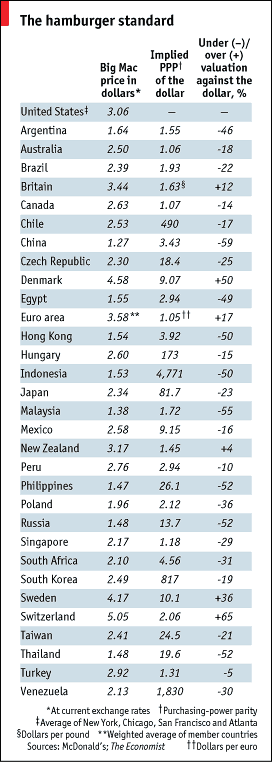|
|
||||||
 |
| About sponsorship |
 | |
ITALIANS like their coffee strong and their currencies weak. That, at least, is the conclusion one can draw from their latest round of grumbles about Europe's single currency. But are the Italians right to moan? Is the euro overvalued?
Our annual Big Mac index (see table) suggests they have a case: the euro is overvalued by 17% against the dollar. How come? The euro is worth about $1.22 on the foreign-exchange markets. A Big Mac costs €2.92, on average, in the euro zone and $3.06 in the United States. The rate needed to equalise the burger's price in the two regions is just $1.05. To patrons of McDonald's, at least, the single currency is overpriced.
The Big Mac index, which we have compiled since 1986, is based on the notion that a currency's price should reflect its purchasing power. According to the late, great economist Rudiger Dornbusch, this idea can be traced back to the Salamanca school in 16th-century Spain. Since then, he wrote, the doctrine of purchasing-power parity (PPP) has been variously seen as a “truism, an empirical regularity or a grossly misleading simplification.”
Economists lost some faith in PPP as a guide to exchange rates in the 1970s, after the world's currencies abandoned their anchors to the dollar. By the end of the decade, exchange rates seemed to be drifting without chart or compass. Later studies showed that a currency's purchasing power does assert itself over the long run. But it might take three to five years for a misaligned exchange rate to move even halfway back into line.
Our index shows that burger prices can certainly fall out of line with each other. If he could keep the burgers fresh, an ingenious arbitrageur could buy Big Macs for the equivalent of $1.27 in China, whose yuan is the most undervalued currency in our table, and sell them for $5.05 in Switzerland, whose franc is the most overvalued currency. The impracticality of such a trade highlights some of the flaws in the PPP idea. Trade barriers, transport costs and differences in taxes drive a wedge between prices in different countries.
More important, the $5.05 charged for a Swiss Big Mac helps to pay for the retail space in which it is served, and for the labour that serves it. Neither of these two crucial ingredients can be easily traded across borders. David Parsley, of Vanderbilt University, and Shang-Jin Wei, of the International Monetary Fund, estimate that non-traded inputs, such as labour, rent and electricity, account for between 55% and 64% of the price of a Big Mac*.
The two economists disassemble the Big Mac into its separate ingredients. They find that the parts of the burger that are traded internationally converge towards purchasing-power parity quite quickly. Any disparity in onion prices will be halved in less than nine months, for example. But the non-traded bits converge much more slowly: a wage gap between countries has a “half-life” of almost 29 months.
Seen in this light, our index provides little comfort to Italian critics of the single currency. If the euro buys less burger than it should, perhaps inflexible wages, not a strong currency, are to blame.
* “A Prism Into the PPP Puzzles: The Microfoundations of Big Mac Real Exchange Rates”. October 2004. Available at www2.owen.vanderbilt.edu/david.parsley/research.htm
| Copyright © 2005 The Economist Newspaper and The Economist Group. All rights reserved. |